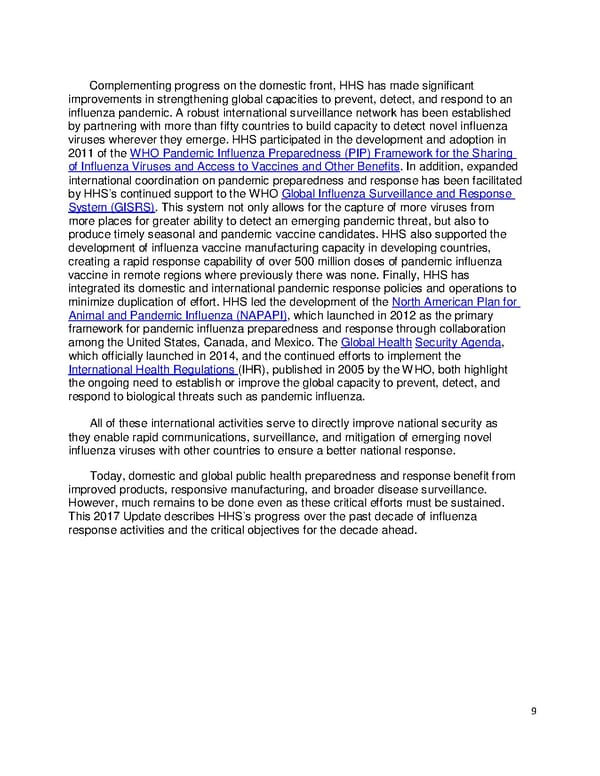Complementing progress on the domestic front, HHS has made significant improvements in strengthening global capacities to prevent, detect, and respond to an influenza pandemic. A robust international surveillance network has been established by partnering with more than fifty countries to build capacity to detect novel influenza viruses wherever they emerge. HHS participated in the development and adoption in 2011 of the WHO Pandemic Influenza Preparedness (PIP) Framework for the Sharing of Influenza Viruses and Access to Vaccines and Other Benefits. In addition, expanded international coordination on pandemic preparedness and response has been facilitated Global Influenza Surveillance and Response by HHS’s continued support to the WHO System (GISRS). This system not only allows for the capture of more viruses from more places for greater ability to detect an emerging pandemic threat, but also to produce timely seasonal and pandemic vaccine candidates. HHS also supported the development of influenza vaccine manufacturing capacity in developing countries, creating a rapid response capability of over 500 million doses of pandemic influenza vaccine in remote regions where previously there was none. Finally, HHS has integrated its domestic and international pandemic response policies and operations to minimize duplication of effort. HHS led the development of the North American Plan for Animal and Pandemic Influenza (NAPAPI), which launched in 2012 as the primary framework for pandemic influenza preparedness and response through collaboration among the United States, Canada, and Mexico. The Global Health Security Agenda, which officially launched in 2014, and the continued efforts to implement the International Health Regulations (IHR), published in 2005 by the WHO, both highlight the ongoing need to establish or improve the global capacity to prevent, detect, and respond to biological threats such as pandemic influenza. All of these international activities serve to directly improve national security as they enable rapid communications, surveillance, and mitigation of emerging novel influenza viruses with other countries to ensure a better national response. Today, domestic and global public health preparedness and response benefit from improved products, responsive manufacturing, and broader disease surveillance. However, much remains to be done even as these critical efforts must be sustained. This 2017 Update describes HHS’s progress over the past decade of influenza response activities and the critical objectives for the decade ahead. 9
 Pandemic Influenza Plan Page 8 Page 10
Pandemic Influenza Plan Page 8 Page 10